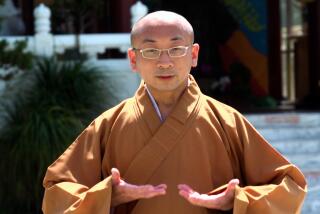Spreading goodness, peace worldwide
- Share via
It begins on a darkened stage. Someone chants. The sound of water flows from speakers. The lights come up slowly in imitation of dawn. A gong sounds, and five monks walk in procession onto the stage. The first one carries a candle and stops in front of an altar and an image of Buddha. The others stand behind him. In quick succession they kneel and stand, kneel and stand.
The ritual, performed by South Korea’s Young San Preservation Group at the Irvine Barclay Theatre this month, is meant to awaken the forces of the natural world. On stage, it was a sacred ceremony condensed -- a five-minute greeting for the day.
In their 80-minute version of the Young San ritual, the group’s eight monks performed traditional dances known as chakpop and music known as pomp’ae -- unwritten chants learned by ear and recited from memory. Pomp’ae, translated to mean “sacred chant,” consists of long, drawn-out melodic lines punctuated by gongs and drums.
The group was touring the United States under the sponsorship of the Korea Society, a nonprofit organization dedicated to promoting awareness and cooperation between South Korea and the U.S. Just hours after the Irvine presentation, the monks headed east for performances at Princeton University and the Smithsonian Institution.
Each performance of the ritual is meant to “spread the goodness of the Buddha to all the world,” the Venerable Dong Hee, a monk and the group’s director, said through a translator.
The music and dance help bring peace not only to those who are still alive but also to the sprits of those who have died unfairly, she said.
Hee has dedicated a lifetime to preserving the rituals of this ceremony, which was nearly lost under restrictions imposed during Japanese colonialism in the first half of the 20th century. She began learning the chants as a child studying under the Venerable Song-am Park, a revered Korean monk who helped preserve the ritual during the colonial period, and is the first woman to join the lineage of the pomp’ae monks.
She learned the music first, then the dancing, she said.
“A profound understanding of the music leads to the dance,” Hee said. “Without understanding the music, there is no dancing.”
When the music fills her body, she said, she imagines the ideal world and tries to send that vision out to those around her.
Shortly after the five-minute awakening performance, five monks took the stage for Insong, a 10-minute chant to request that all Bodhisattvas -- enlightened beings -- attend the ceremony.
Chanting, interspersed with cymbal dances, a drum dance and a butterfly dance, followed.
In one cymbal dance, six monks walked in procession onto the stage, each carrying a pair of brass cymbals. They waved them over their heads, then brought them together -- not quite touching at first, then sliding them against each other ever so lightly so that the slightest reverberations could be heard around the theater. They did this three times in unison, then knelt together on the floor. The soft tap, tap, tap was followed by a louder clash. The shiny, pounded-metal cymbals were like a cluster of fluttering autumn leaves.
The monks stood again and danced with cymbals overhead. They bowed and most walked slowly off the stage, leaving one behind to chant alone.
A few minutes later, Hee stood in front of a drum, drumsticks in hand, and played and danced alone. The drum dance is a wish, she said, that all beings be enlightened in response to the beat.
In the butterfly dance, the monks entered in flowing robes and brightly colored headdresses. Each one carried a large peony and stepped slowly in rhythm around the center of the stage. They extended their arms like butterflies and then knelt to the floor.
The final performance was a 10-minute chant by Hee, accompanied by a lone drummer. The lights were dimmed for a time, then came up slowly as the drumbeat and the chant picked up speed.
It is a supplication, the group says, that all the blessings from the ceremony be transferred to the realization of peace.
--
More to Read
Sign up for Essential California
The most important California stories and recommendations in your inbox every morning.
You may occasionally receive promotional content from the Los Angeles Times.













